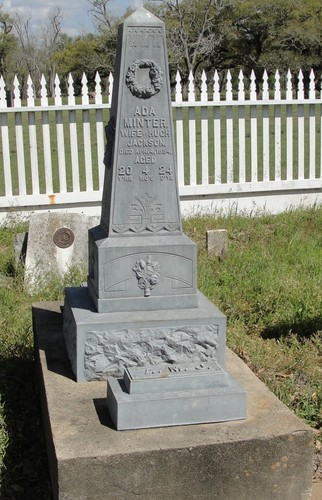.JPG) White Bronze Grave Markers
White Bronze Grave MarkersBy Kevin Ladd
Having spent far too much time poking around in cemeteries, I have picked up a lot of information about different kinds of grave markers. Most of us are geared to stone grave markers, usually carved from granite or marble and sometimes other materials. But one of the more interesting types is grave markers were commonly called "White Bronze" monuments.
White bronze is a metal that serves two common purposes. It is actually not bronze, but an alloy of varying amounts of copper, tin and zinc. Now days it is commonly used in jewelry as a substitute for nickel, and was used many years ago as a material for grave markers. Though it is no longer used for the second purpose, it was well-suited to that application at the time.
It is nonmagnetic, very smooth, and virtually nonporous. It is also highly resistant to corrosion and breakdown. White bronze also offers one advantage that silver does not, namely that it will not tarnish. White bronze markers erected on grave sites a hundred years ago still look as attractive as they did when first placed there. In certain parts of the country where acid rain or simply the steady advance of time has exacted a heavy toll upon traditional stone markers, the white bronze monuments have held up pretty well.
From the 1870s through the 1910s, white bronze was used as a raw material for grave markers by certain manufacturers. This type was mostly zinc, rather than the mainly tin alloy used in jewelry today. It was called white bronze as a marketing ploy to make it sound more attractive. Gravemarkers made of this material usually took on a pale gray or pale blue appearance, and stood up to the elements better than stone markers because they were less porous. These gravemarkers were actually hollow, and consisted of vertical panels held together by screws at the corners. It is said that outlaws sometimes took advantage of this fact, and hid stolen goods inside the tall, hollow monuments. During Prohibition times, criminal elements could remove one of the panels and leave liquor inside the monument for their customers.
The Monumental Bronze Company of Bridgeport, Connecticut produced sand cast zinc grave markers (sold as "White Bronze") from 1874 to 1914. The company's product is in cemeteries from coast to coast both in the United States and Canada. Usually there are just two or three examples in a cemetery, if any at all. Mt. Hope Cemetery has 12 burial sites that are marked with zinc. The map below shows these locations.
Zinc grave markers stand out in a field of stone markers because of their characteristic blue gray color. After the markers sections were cast and assembled, they were sandblasted to roughen the surface, then treated with a metal finishing process called "steam bluing" which consists of covering the surface with a thin film of linseed oil, then hitting the surface with steam under a minimum pressure of 50 pounds per square inch.
The metal is nearly 100% pure. It weathers very well, and monuments made from zinc frequently look as good today as they did when they were first installed. They age better than marble, and are equal to the lasting qualities of granite. The markers were sold with the claim that they would last a long time, were about 1/3 less expensive than an equivalent marker carved from stone, and were modern and progressive. Their disadvantage is that zinc is brittle so the markers can be broken. Also, over time, large markers "creep" (sag), and so require an internal structure to support them.
Most of the markers have bolt-on panels so that an older monument could be kept up-to-date with newer burials. The panels themselves were made through 1939. A special tool, looking vaguely like a screwdriver but with a negative rosette bolt head where the end of the screwdriver blade would be, was used to loosen and tighten the cast zinc nuts.
There are a few of these monuments scattered in Chambers County -- namely in the Wallis, Jackson and Chapman cemeteries. If you know of additional white bronze or zinc grave markers in our area, please send me an email atwallisville@gmail.com
